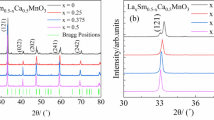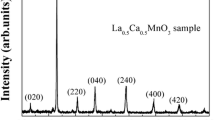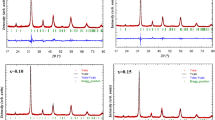Abstract
In this work, we report the attractive magnetic properties of La1-xCaxMnO3 manganites with x = 0.2 (LCMO-2) and x = 0.5 (LCMO-5). X-ray diffraction (XRD) measurements show that the prepared samples are single phase and they crystallize in the orthorhombic structure with Pnma space group. Scanning electron microscope (SEM) measurements reveal that the particles of samples are homogeneous and possess the diameter of several microns. Magnetization versus temperature measurements show paramagnetic (PM) to ferromagnetic (FM) transition at TC ≈ 200 K for LCMO-2 and at TC ≈ 250 K for LCMO-5. Below TC, FM nature is observed in LCMO-2. However, LCMO-5 displays the complex magnetic phase transition. Below TC, LCMO-5 shows a FM to charge-ordered antiferromagnetic (COAFM) transition at CO temperature TCO and a novel, unexpected FM phase transition at characteristic temperature T* (near 35 K). The FM and COAFM phases coexist in LCMO-5, and the competition of FM and AFM phases lead to the unexpected FM transition at T*. Furthermore, the inverse of susceptibility versus temperature measurements confirm the similar results. Magnetic hysteresis loop measurements suggest the typical FM feature of LCMO-2. However, LCMO-5 exhibits the hysteresis loops with butterfly-type structure at 100 and 150 K, suggesting the presence of COAFM phase. These attractive magnetic properties are explained by the existence of COAFM phase and the competition between FM and COAFM phases.
Similar content being viewed by others
Avoid common mistakes on your manuscript.
1 Introduction
Perovskite La1-xCaxMnO3 manganites have attracted a lot of attention because of their fascinating properties such as enormous magnetoresistance (MR) [1], ferromagnetic (FM) metal to paramagnetic (PM) insulator transition [2, 3], charge-ordered phase separation [4], and magnetocaloric effect [5, 6]. For manganites, La1-xCaxMnO3 compounds with 0.2 < x < 0.5 show FM metallic phase below Curie temperature [2, 7]. This phenomenon can be explained by the double-exchange (DE) theory [8]. Moreover, the FM phase and metallic behavior in hole-doped manganites is closely related to other effects, such as charge-ordered (CO) state [4, 9], A-site cation radius/size [10, 11], and oxygen content [7]. At doping value x = 0.5, La1-xCaxMnO3 compound shows charge ordering [4, 12]. Below CO temperature TCO, La1-xCaxMnO3 with x = 0.5 reveals antiferromagnetic (AFM) insulating phase. The charge-ordered antiferromagnetic (COAFM) insulating phase of La1-xCaxMnO3 compounds is able to be converted into FM metallic (FMM) phase by external perturbations such as doping amount and element, magnetic field, temperature, and strain [13,14,15].
In these works, the influence of oxygen deficiency, doping concentration, grain size, and strain on transport properties of perovskite manganites have been investigated. However, the systematic and comprehensive studies on the magnetic properties of La1-xCaxMnO3 compounds with x = 0.2 (LCMO-2) and x = 0.5 (LCMO-5) are still lacking. Specially, there are few studies on magnetic response of the COAFM phase in LCMO-5. Considering these realities, magnetic properties of LCMO-2 and LCMO-5 deserve further investigation. In this work, we study the structure and magnetic properties of LCMO-2 and LCMO-5 and focus on the magnetic response of the COAFM phase in LCMO-5. The LCMO-2 sample shows a normal FM nature, whereas the LCMO-5 sample shows the butterfly-type M(H) loop and a significant peak of CO state in M(T) and χ−1(T) curve, indicating the complex multiple phase transition.
2 Experimental Details
The polycrystalline LCMO-2 and LCMO-5 powder samples were synthesized using the traditional solid-state reaction technique by mixing 99.99% purity raw powders of La2O3, CaCO3, and MnO2. The reaction equation was as follows:
Stoichiometric raw powders of La2O3, CaCO3, and MnO2 for the LCMO-2 and LCMO-5 were intimately mixed and thoroughly ground, then were heated at 900 °C for 24 h. The obtained powders were then pressed into disk-shaped pellets with the diameter of 10 mm and the thickness of 1–2 mm. These pellets were first sintered at 1100 °C for 24 h and then were sintered at 1350 °C for 24 h. Finally, these pellets were slowly cooled down to room temperature.
The crystalline structure (phase purity) was determined by X-ray diffraction with high resolution (HRXRD) at Beijing Synchrotron Radiation Facility (BSRF) with the X-ray wavelength λ = 0.15405 nm. Surface morphology was studied by the scanning electron microscope (SEM). Magnetization measurements were performed using quantum design PPMS-VSM magnetometer.
3 Results and Discussion
The crystallographic structures of LCMO-2 and LCMO-5 compounds are determined by the HRXRD. Figure 1 a and b show the typical HRXRD θ–2θ scans for the LCMO-2 and LCMO-5 samples, respectively. The results of HRXRD demonstrate that the prepared LCMO-2 and LCMO-5 are single phase without phase impurity; the XRD can be indexed in an orthorhombic structure with Pnma space group, which are similar with previous relevant reports [16, 17].
The insets of Fig. 1 a and b show the SEM images of the LCMO-2 and LCMO-5 compounds prepared by the solid-state reaction. The agglomeration and irregular boundaries are observed clearly. The particles size can be calculated by measuring the maximum and minimum diameter of a lot of particles. The particles of the two samples reveal the diameter of several microns, indicating the homogeneity of the obtained LCMO-2 and LCMO-5 samples.
Magnetization measurements as a function of temperature under 100 Oe field are performed. Figure 2 a and b show the zero-field-cooling (ZFC) magnetization versus temperature curves for the LCMO-2 and LCMO-5 samples, respectively. In Fig. 2a, LCMO-2 sample shows a PM-FM transition at TC ≈ 200 K with decreasing temperature. This transition temperature TC is marked by an arrow. TC is determined from the plot of dM/dT versus temperature, as shown in the inset of Fig. 2a. In Fig. 2b, LCMO-5 sample shows a PM-FM transition at TC ≈ 250 K with decreasing temperature. Further decreasing temperature, there is an anomalous peak with an arrow in the temperature range of 200–230 K, suggesting the existence of CO phase. It is believed that the temperature of this peak corresponds to the CO temperature TCO (about 210 K). Below TCO, the LCMO-5 sample begins to reveal the COAFM state and then exhibits a normal FM behavior with temperature T < 150 K. Therefore, the FM and COAFM phases coexist in LCMO-5 at temperature lower than TCO. Remarkably, magnetization sharply increases at characteristic temperature T* (about 35 K), marked by an arrow. This sudden rise of magnetization is related to the percolation of FM phase in LCMO-5. The percolation of FM phase in half-doped manganite can induce the huge rise of magnetization at low temperature, which has been confirmed by previous reports [18, 19]. The values of TC, TCO, and T* are clearly determined from the plot of dM/dT versus temperature, as shown in the inset of Fig. 2b. The TC is found to increase from 200 K for x = 0.2 to 250 K for x = 0.5.
Figure 3 a and b show the temperature dependence of ZFC and FC in 100 Oe field magnetization for LCMO-2 and LCMO-5, respectively. During the measurement, the applied field is kept as 100 Oe. In Fig. 3a, the FC M(T) curve shows a saturation in magnetization at low temperature. The saturation magnetization MS reaches 8 emu/g. The LCMO-2 sample shows a normal FM behavior. However, the LCMO-5 sample shows a complex multiple phase transition, as shown in Fig. 3b. With decreasing temperature, ZFC and FC M(T) curves converge, separate, cross, and finally converge near T*. The complex phase transition needs further discussion. The separation of ZFC and FC M(T) curves below 220 K is a signature of spin glass state due to the magnetic frustration between the FM double-exchange and AFM superexchange interactions [20, 21]. Moreover, the intercross in ZFC and FC M(T) curves is related to the competition between FM and COAFM phases [20]. Below TCO, the crystalline structure of LCMO-5 sample with COAFM phase starts to change from orthorhombic to monoclinic lattice [12]. Near TCO, the orthorhombic and monoclinic structures coexist in the LCMO-5. Therefore, the coexistence of multiple structural phases and the competition of FM and COAFM phases eventually lead to the intercross of the ZFC and FC M(T) curves in Fig. 3b.
In order to further investigate the magnetic properties and to confirm the multiple magnetic phase transition at low temperature, we report the magnetic hysteresis loops measured at different temperatures and the temperature dependence of inverse susceptibility. Figure 4 shows the M(H) loops of LCMO-2 sample at 5, 100, and 200 K. We find a typical FM behavior in the LCMO-2 sample. The saturation magnetization MS shifts to higher values with decreasing temperature and it reaches 32 emu/g at 5 K. Moreover, the coercive field HC at different temperatures is very small, as shown in the inset of Fig. 4. Figure 5 a–f show the M(H) loops of LCMO-5 sample at 5, 100, 150, 200, 250, and 300 K. In Fig. 5a, b, at temperature of 300 and 250 K, the M(H) loops are linear and LCMO-5 sample shows typical PM nature. With decreasing temperature down to 200 K, LCMO-5 sample begins to become FM-like behavior, as shown in Fig. 5c. Interestingly, in Fig. 5d, e, the M(H) loops at 150 and 100 K show a butterfly-type structure, with hysteresis opening under higher magnetic field and pinching under lower magnetic field. The butterfly-type M(H) loops suggest the existence of COAFM phase. In Fig. 5f, a normal FM nature is observed at 5 K, but the value of MS is very small (only 1.3 emu/g), indicating a weak FM ordering. This observed weak FM moment in LCMO-5 is attributed to the existence of COAFM phase at low temperature. It is evident from M(H) loops at various temperatures that the COAFM and FM phases coexist in the LCMO-5 sample. This result is consistent with that of M(T) curve in Fig. 2b. The complex magnetic phase transition in the LCMO-5 is determined by the interaction between FM and COAFM phases.
Figure 6 a and b show the temperature dependence of the inverse of susceptibility χ−1(T) for LCMO-2 and LCMO-5 manganite, respectively. At high temperature, these compounds exhibit normal PM behavior and could be fitted by the Curie-Weiss law. With decreasing temperature, for LCMO-2, it undergoes a PM to FM transition. However, for LCMO-5, the coexistence of various magnetic phases occurs in the low-temperature region. It can be found that an AFM phase appears at TCO, and a FM phase percolation occurs at T*. These phenomena are consistent with M(T) and M(H) measurements, as shown in Figs. 2b, 3b, and 5. The complex magnetic behaviors are caused by FM percolation at low temperature and the combination of FM and COAFM phases.
4 Conclusions
In summary, the structural, morphological, and magnetic properties of LCMO-2 and LCMO-5 samples have been investigated. The prepared LCMO-2 and LCMO-5 samples are homogeneous and they crystallize in the orthorhombic (Pnma) structure. The LCMO-2 sample exhibits a normal FM phase transition with decreasing temperature. Interestingly, the CO temperature TCO (an indication of COAFM phase) and characteristic temperature T* (an indication of FM phase percolation) have been observed in the M(T) and χ−1(T) curves of LCMO-5 sample. Moreover, the LCMO-5 sample exhibits the abnormal hysteresis loops with butterfly-type structure at 100 and 150 K, which is related to the presence of COAFM phase below TCO. For these fascinating magnetic properties, we offer a brief scenario as the explanation by the interaction between FM and COAFM phases.
References
Tokura, Y.: Rep. Prog. Phys. 69, 797 (2006)
Martinez, J.L., de Andrés, A., Garcia-Hernandez, M., Prieto, C., Alonso, J.M., Herrero, E., Gonzalez-Calbet, J., Vallet-Regi, M.: J. Magn. Magn. Mater. 196, 520 (1999)
Krichene, A., Solanki, P.S., Rayaprol, S., Ganesan, V., Boujelben, W., Kuberkar, D.G.: Ceram. Int. 41, 2637 (2015)
Amirzadeh, P., Ahmadvand, H., Kameli, P., Aslibeiki, B., Salamati, H., Gamzatov, A.G., Aliev, A.M., Kamilov, I.K.: J. Appl. Phys. 113, 123904 (2013)
Koubaa, M., Cheikhrouhou-Koubaa, W., Cheikhrouhou, A.: J. Alloy. Compd. 473, 5 (2009)
Quintero, M., Passanante, S., Iruzun, I., Goijman, D., Polla, G.: Appl. Phys. Lett. 105, 152411 (2014)
Trukhanov, S.V., Kasper, N.V., Troyanchuk, I.O., Tovar, M., Szymczak, H., Bärner, K.: J. Solid State Chem. 169, 85 (2002)
Zener, C.: Phys. Rev. 82, 403 (1951)
Jirak, Z., Hadova, E., Kaman, O., Knizek, K., Marysko, M., Pollert, E., Dlouha, M., Vratislav, S.: Phys. Rev. B. 81, 024403 (2010)
Damay, F., Martin, C., Martin, A., Raveau, B.: J. Appl. Phys. 81, 1372 (1997)
Rodriguez-Martinez, L.M., Attfield, J.P.: Phys. Rev. B. 54, 15622 (1996)
Kekade, S.S., Devan, R.S., Deshmukh, A.V., Phase, D.M., Choudhary, R.J., Patil, S.I.: J. Alloy. Compd. 682, 447 (2016)
Takamura, Y., Yang, F., Kemik, N., Arenholz, E., Biegalski, M.D., Christen, H.M.: Phys. Rev. B. 80, 180417(R) (2009)
May, S.J., Ryan, P.J., Robertson, J.L., Kim, J.-W., Santos, T.S., Karapetrova, E., Zarestky, J.L., Zhai, X., te Velthuis, S.G.E., Eckstein, J.N., Bader, S.D., Bhattacharya, A.: Nat. Mater. 8, 892 (2009)
Burgy, J., Moreo, A., Dagotto, E.: Phys. Rev. Lett. 92, 097202 (2004)
Sarkar, T., Raychaudhuri, A.K., Chatterji, T.: Appl. Phys. Lett. 92, 123104 (2008)
Sarkar, T., Ghosh, B., Raychaudhuri, A.K., Chatterji, T.: Phys. Rev. B. 77, 235112 (2008)
Wang, H.O., Dai, P., Liu, H., Tan, W.S., Xu, F., Wu, X.S., Jia, Q.J., Hu, G.J., Gao, J.: Int. J. Mod. Phys. B. 26, 1250132 (2012)
Wang, H.O., Chu, Z., Su, K.P., Tan, W.S., Huo, D.X.: J. Alloy. Compd. 689, 69–74 (2016)
Liang, S., Sun, J.R., Wang, J., Shen, B.G.: Appl. Phys. Lett. 95, 182509 (2009)
Wang, H., Yang, W., Su, K., Huo, D., Tan, W.: J. Alloy. Compd. 648, 966 (2015)
Acknowledgments
We thank our colleagues at Beijing Synchrotron Radiation Facility (BSRF) and Shanghai Synchrotron Radiation Facility (SSRF) for their help.
Funding
This work was supported by the Young Scientists Fund of the National Natural Science Foundation of China (11604067, 21801054, 51601049, 11704091) and the National Natural Science Foundation of China (U1832143, 11574066).
Author information
Authors and Affiliations
Corresponding authors
Additional information
Publisher’s Note
Springer Nature remains neutral with regard to jurisdictional claims in published maps and institutional affiliations.
Haiou Wang is the first author
Rights and permissions
About this article
Cite this article
Wang, H., Su, K., Huang, S. et al. Magnetic Properties and Charge Ordering in Polycrystalline La1-xCaxMnO3 (x = 0.2, 0.5) Manganite. J Supercond Nov Magn 32, 3887–3891 (2019). https://doi.org/10.1007/s10948-019-05152-2
Received:
Accepted:
Published:
Issue Date:
DOI: https://doi.org/10.1007/s10948-019-05152-2










